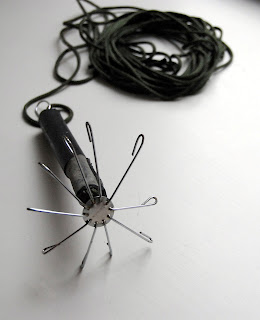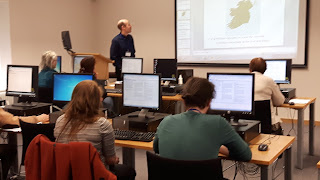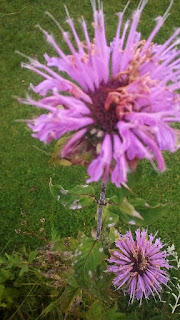 |
| Pondweeds are tricky! This is Potamogeton crispus Image courtesy of John Crellin http://www.floralimages.co.uk/page.php? taxon=potamogeton_crispus,1 |
We have already featured seven budding botanists on these pages who have benefited from a BSBI Training Grant in 2015 and now here is number eight.
Over to Karen to tell us about the course that she was able to attend, thanks to the grant, and how it has helped her progress as a botanist:
Over to Karen to tell us about the course that she was able to attend, thanks to the grant, and how it has helped her progress as a botanist:
"Last summer I was lucky enough to be awarded
a BSBI Training Grant to undertake the Aquatic Plants course run by Sarah Whild and Nick
Law at Preston Montford Field Studies Council Centre,
 |
| Essential kit for botanists hunting for aquatics: grapnel, ID key & notes from a great training course! Image: K. Rogers |
While confident with other groups of
plants, I would always dodge anything truly aquatic and felt like I was doing
my local ponds a disservice. While it is perfectly acceptable for botanists to
want to specialise in terrestrial plants, to me aquatic plants seemed a
challenge (and I always like a challenge) and a piece of the botanical jigsaw
that I was then missing.
Although I was working on a short term
contract when I applied for the grant, my employment was only secure until
March of 2015. The grant money, therefore, enabled me to do this personal
development without worrying about having to find the whole amount out of my
savings.
 |
| Flowers of Alternate Water-milfoil Image courtesy of John Crellin http://www.floralimages.co.uk/page.php? taxon=myriophyllum_alterniflorum,1 |
All participants on the course received a fantastic
array of keys produced by Sarah and Nick which provide surveyors with a quick
and easy starting point for all aquatics and emergents. We used them throughout
the course, adding our own notes, and then we were able to take them away with
us. I have actually photocopied and laminated my set so that they don’t spoil
when you have wet and muddy hands.
The other great thing about the course was the focus on self-learning. We keyed out all the specimens we encountered, rather than being told what something was and moving on to the next specimen. This gave me confidence in using the available keys and taught me to trust my botanical instinct.
 |
| Karen's home-made grapnel - you throw it into the water and fish out plants. Make sure you hold on to the other end! Image: K. Rogers |
With hindsight, the course armed me with
the materials I need to sample, identify in-situ or gather and preserve plants
in and around water. And, more importantly, I have been able to put this into
practice in my work. I was the only person at work with a grapnel and all the
right materials to survey a series of ponds and assess their wildlife value. It
was very satisfying to learn these skills and then put them to good use.
Many thanks to Karen for telling us about the Aquatics Course - we're delighted that your BSBI Training Grant was put to such good use!
You can find out more about the range of botanical training opportunities - from short courses for beginners to post-graduate and professional qualifications - on the BSBI Training page here.





























